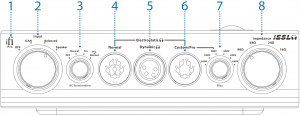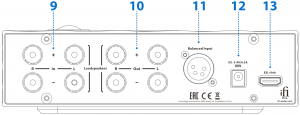
—— User Manual
Thank you for purchasing this Pro series iESL. The Pro iESL is an audiophile-grade ‘energiser’ for electrostatic headphones. It can also be used to match dynamic headphones to powerful loudspeaker amplifiers.
While designed to match the iFi Pro iCAN, the Pro iESL can be used equally well with sufficiently powerful headphone amplifiers and also loudspeaker amplifiers via dedicated separate inputs.
Note: The Pro iESL is not a headphone amplifier. It is a matching device that allows electrostatic headphones to be used with normal headphone/loudspeaker amplifiers. It requires an external power amplifier to drive the headphones.
Key features:
- Upgrades iCAN Pro to drive electrostatic headphones using the ESL-Link
- Upgrades all standard headphone amplifiers to drive electrostatic headphones#
- Upgrades all loudspeaker amplifiers to drive electrostatic/dynamic/planner headphones
- Capacitive Battery Power Supply eliminates all AC and switching noise
- Adjustable AC termination: Pro/Normal/Off
- Custom Bias adjustment: 500 – 640V
- Loading impedance adjustment: 16Ω – 96Ω
# Sufficient power / voltage output from the HP Amplifier is required (>10V/16R)
1

1. LED2. Input Selector3. AC Termination Adjustment4. Normal Bias Electrostatic Headphone Socket5. Dynamic Headphone Socket6. Pro and Custom Bias Electrostatic Headphone Socket7. Custom Bias Adjustment (500V-640V)8. Impedance Adjustment (16Ω – 96Ω)
2

9. Loudspeaker Inputs10. Loudspeaker Outputs11. Balanced Signal Input12. DC Power Supply Connection13. ESL-Link
3
1. LEDOrange: power on (either via DC power supply or ESL-Link)Tip: There are 2-ways to power the iESL, see ESL-Link and DC power supply sections.
2. Input SelectorOff iESL is off.Pro iCAN Pro iCAN via ESL Link.On this setting, the iESL will turn on/off with the iCAN Pro.Balanced Headphone Amplifier via rear XLR input loudspeakerLoudspeaker Amplifier via rear loudspeaker inputsOn this setting, the Loudspeaker Output will turn off.
3. AC Termination AdjustmentOff AC Termination is offNormalAC Termination Normal Bias Socket onlyPro AC Termination Pro Bias Socket onlyNormal/Pro AC Termination Normal & Pro Socket
Tip: AC termination affects the operation of the headphone, by either making the bias node that is shared between both channels high impedance, and low impedance for audio signals. This affects a complex set of parameters, but audibly mainly affects the presentation of the 3D soundscape.
4
4. Normal Bias Electrostatic headphone socket6-pin socket for older Stax Headphones, 230V Bias Voltage
5. Balanced Dynamic headphone socket4-pin XLR socket for dynamic headphones, including AKG K-1000 and any compatible wired headphone, including Audeze.
6. Pro/Custom Bias Electrostatic headphone socket5-pin socket for modern Stax headphones, 500V to 640V adjustable Bias Voltage
7. Bias Voltage settingNote: Before turning on the iESL, set the bias voltage according to the above table, or according to the recommendation given by the electrostatic headphone manufacturer.
Bias voltage usage:230V (Normal) Older Stax ESHP500V (Custom) Sennheiser Orpheus HE-90540V (Custom) Sennheiser HE-60, King Sound KS-H2/3/4580V (Pro) Stax Pro Bias ESHP600V (Custom) Koss ESP/950, Jade620V (Custom) Future option
5
640V (Custom) Future option
8. Impedance AdjustmentThe impedance response can be adjusted from 16Ω to 96Ω. This impedance describes the load impedance for the driving amp with a “standard” electrostatic headphone connected.
Lower impedance settings create a greater step-up and will produce a louder sound level at the same headphone amplifier volume setting.
Lower impedance settings are a much more difficult load for the driving amplifier.
Please adjust to suit listening preferences, however, in most cases the higher impedance setting is recommended.
9. Loudspeaker InputsConnect loudspeaker cables from your loudspeaker amplifier.
The amplifier rating should not exceed 100W/8Ω rating for safe operation, or care must be taken when setting the volume. Ratings below around 10 Watt/8Ω may not deliver satisfactory playback levels.
6
10. Loudspeaker OutputsConnect loudspeaker cables to your loudspeakers.Switching the input selector to loudspeaker turns off the loudspeakers and connects the iESL circuitry to the loudspeaker amplifier.
Tip: While the iESL Input selector is OFF, or any input except loudspeaker is selected, the loudspeaker input is linked to the loudspeaker output and disconnected from the iESL circuitry.
11. Balanced Headphone Amplifier InputConnect this to any 4-Pin XLR equipped headphone amplifier you wish to use. It is recommended that amplifier should be able to deliver at least 10V into 64Ω, as much as 28V/64Ω are permissible.
12. Power Supply Connection5V – 9V/1A DC Power input. Use the supplied iFi iPower for standalone operation without the Pro iCAN.
No extra power supply is needed if the Pro iESL is connected to the Pro iCAN via the ESL-Link cable directly.
13. Connector for iFi Pro iCAN Link ModuleConnect the Pro iCAN ESL-Link socket to the Pro iESL ESL-Link socket using the cable supplied.
7
DO NOT CONNECT ANY OTHER EQUIPMENT! This is only reserved for the iFi Pro iCAN headphone amplifier using the supplied cable!
Specifications:
- Maximum Output voltage: 640V RMS (16Ω/20V in), 320V RMS (64Ω/20V in)
- Frequency Response: 5Hz-50kHz (-3dB)
- Input Voltage (Pro iESL): 5V-9V/1A max
- Input Voltage (iPower): AC 85-265V, 50/60Hz
- Power Consumption: < 1W
- Dimensions: 213(l) x 206(w) x 63.3(h) mm
- Weight: 2.5kg (5.5 lbs)
- Warranty period: 12 months
Specifications are subject to change without notice.
8
Notes on Electrostatic HeadphonesElectrostatic headphones require very high voltages for operation. For example, Stax are around 101dB @ 100V, compared to around 105dB @ 1V for a common inefficient full size headphone. On top of that, they need a ‘bias voltage,’ usually 580V for modern Stax.
The Pro iESL offers both the original (normal) 230V Bias for 6-pin plug connected Stax headphones and adjustable bias from 500V to 640V (including a dedicated 580V setting for Stax Pro bias) for 5-Pin connected Stax electrostatic headphones. It can also accommodate many other manufacturers electrostatic headphones if adapters to Stax 5-Pin pro connection are used.
Different bias settings may be tried. Note that it will take a considerable time for the voltage to fall from a previous higher setting. Therefore, if testing different bias settings, it is best to start with the lowest setting and slowly work up towards the nominal voltage.
More bias produces a louder mid-range, while the bass remains at the original level. So lower bias may give a more warm sound, higher more bright.
Exceeding the rated bias for a given headphone may damage it, so it is not recommended and exceeding the rated bias is done at your own risk.
Warning: AMR/iFi is not responsible for any damage arising from using the Pro iESL and or Pro iCAN with incorrect settings.
Notes on Use with Pro iCANMost electrostatic headphones are very inefficient. Due to the limited voltage handling and the low sensitivity, electrostatic headphones generally do not play very loudly, especially compared to traditional dynamic headphones.
9
Depending on the impedance control setting the Pro iCAN and Pro iESL combo can deliver between 320V RMS (910V PP) to 640V RMS (1820V PP).
These are very high voltage levels and may exceed the rated limit of the electrostatic headphones. Please confirm with your electrostatic headphone manufacturer what levels are allowed and, if in any doubt, only use the high impedance settings.
When using the iESL with Pro iCAN, remember to keep the Gain, XBass and 3D Sound settings moderate. Gain is recommended at 9dB, 3D only at the lower settings and the same for XBass, as otherwise the stress on both amplifier and headphone may be excessive.
Under the above conditions the volume on the Pro iCAN should be able to be advanced to maximum (using an iFi DAC) without risk of protection circuitry engaging or damaging ANY electrostatic headphones as long as the Pro iESL impedance setting is 64Ω or 96Ω.
Notes on the iESL DesignIn principle, an energiser for electrostatic headphones is a trivial challenge. All we need are a pair of transformers to create the very high signal voltages for the electrostatic headphones and some form of bias supply. Of course, what seems simple usually hides unexpected complexity.
For example, to make transformers that can turn 20V audio signals into a 640V signal, with low distortion, a flat frequency response and without obnoxious resonances is a serious challenge. Get it wrong and the sound will be coloured, something especially objectionable with the crystal-clear sound of electrostatic headphones.
In addition, while making a high voltage bias supply seems easy, we must remember that this bias voltage provides one part of the motive force that moves the diaphragm. Any noise on the bias supply will modulate the drive strength of the moving diaphragm and thus the sound. Obviously, this must be avoided.
10
Given the high voltages involved even trivial jobs like circuit board design become challenging as we must avoid any chance of these high voltages to get out of control. Therefore great amounts of spacing between voltage carrying traces and pins are needed, making a simple circuit board layout suddenly very challenging.
Then we need to make sure we can select multiple sources, with minimal impact on sound quality from the switches and good long term reliability, something that simple mechanical switches fail to deliver.
The TransformersIn order to produce the high voltages requires by electrostatic headphones, the Pro iESL employs custom-made transformers of the highest quality.
The extremely critical core of the transformers is a hybrid that combines ultra-thin GOSS with “pinstripe” permalloy lamination. A 100% GOSS core suffers from hysteresis at low levels causing distortion in quiet passages. Meanwhile a 100% permalloy core cannot handle high levels without gross distortion. Combining the two materials makes sure each operates at its best. This reduces distortion dramatically, when compared to traditional cores, be they GOSS, amorphous iron or similar materials.
In order to combine a high step-up ratio with good behaviour without excessive resonances or bandwidth limitations, our custom transformers use a complicated multi-section winding with both vertical and horizontal sectioning. Extremely thin wire must be wound precisely and tightly to create the performance we required.
Combining this complex winding with an exceptional core produces a transformer that handles all levels without obvious distortion as well as offering a completely flat frequency response without colorations well past the audio band.
Only with such an exceptional transformer can we approach and even exceed the best transformer-less amplifier in terms of performance.
11
The Bias System – Capacitive Battery Power SupplyCommonly the bias voltage is created using the 50/60Hz mains power and a so-called Villard or Greinacher cascade rectifier (which is also sometimes called a Cockcroft-Walton voltage multiplier) is employed. This circuit can deliver very high voltages using rather generic and inexpensive components, but its operation is noisy.
Given the low frequencies of the AC used, large value capacitors tend to be needed, usually requiring rather nonlinear electrolytic capacitors, which have high leakage currents and so the cascade rectifier must operate constantly to keep the Bias Voltage from dropping.
At iFi we decided to completely toss out all existing solutions.
First, we decided to use a battery of multiple parallel film capacitors to provide the bias voltage. Film Capacitors hold their charge almost indefinitely. Given that isolation resistance of the electrostatic headphone is also very, very high, no current flows to discharge the capacitor bank. Therefore, if we charge the capacitor bank up to the nominal bias one time, we can simply leave the charged capacitor bank to “float” at the Bias Voltage.
In order to provide this one time charge we employ a very high frequency switching system (appx. 750kHz). This system uses a tiny, fully shielded transformer and exotic ultra-fast high voltage rectifiers. More crucially, this system shuts down completely as soon as the correct bias voltage has been established in the capacitor bank.
As some minor discharge happens even through air, we do need to top up the capacitor bank every 30 seconds or so. This process usually takes a few millionth of a second (microseconds) as usually one or two switching cycles suffices to replenish the lost charge. Then the switching system is again off completely.
Any noise that this system creates is confined to medium frequency radio bands for the infrequent short durations during which it is active. For over 99.999% of the time the charging circuit is completely off.
The result is in effect a perfect high voltage battery to provide the bias for the electrostatic headphones. Two completely separate and independent bias circuits are employed, one for the 230V “normal” bias and another adjustable, to cover a wide range of modern electrostatic headphones.
The Signal RoutingThe entire signal switching for the input selection utilises gold-plated silver contact miniature relays filled with an inert gas. This makes sure the contacts will remain like new for a long time to come.
The loudspeaker connections are switched using sealed silver alloy contact relays for minimum impact on the sound quality of the loudspeaker path.
13

139-141 Cambridge Road, Churchtown, Southport, PR9 7LN, United Kingdomwww.ifi-audio.com
Ver1.1
References
[xyz-ips snippet=”download-snippet”]




